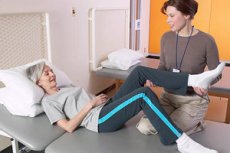
All iLive content is medically reviewed or fact checked to ensure as much factual accuracy as possible.
We have strict sourcing guidelines and only link to reputable media sites, academic research institutions and, whenever possible, medically peer reviewed studies. Note that the numbers in parentheses ([1], [2], etc.) are clickable links to these studies.
If you feel that any of our content is inaccurate, out-of-date, or otherwise questionable, please select it and press Ctrl + Enter.
Recovery from a femoral neck fracture
Medical expert of the article
Last reviewed: 04.07.2025

A hip fracture is a common injury that occurs in older people, as they are let down by poor vision, limited mobility, and sometimes impaired coordination. A fall from a height of one's own height with brittle bones, which is common in people over 60, can sometimes be fatal. Such injuries also occur in younger people. Doctors say that it is not the fracture that is dangerous, but the complications it causes. Recovery largely depends on the correct recovery period after the injury. [ 1 ]
Recovery time after surgery
A good chance to return to your previous lifestyle is provided by hip replacement surgery or osteosynthesis – the use of fastening structures. After this, the patient remains in the hospital for another 10-14 days under the supervision of doctors, where they carry out the necessary therapeutic measures to avoid complications, help stand on crutches and take the first steps. [ 2 ]
This is followed by long-term rehabilitation at home or in a specialized institution, in which the patient must take an active part. [ 3 ]
The recovery period after surgery depends on many factors, including age, general health, muscle tone, psychological attitude, quality of care, and can range from 2 months to a year. Doctors recommend using crutches for the first 1.5-2 months.
Rehabilitation activities include:
- medicinal support (painkillers, sedatives, decongestants, vitamin complexes, calcium preparations, immunostimulants);
- physiotherapy: water treatments, magnetic, cryo, laser therapy, electrical stimulation (accelerate metabolic processes, blood microcirculation, relieve pain, strengthen muscles);
- therapeutic exercise (increases joint mobility);
- massage (increases blood flow, saturates tissues with oxygen);
- diet (will help you lose excess weight, will ensure that your body receives the necessary substances);
- psychotherapy (reduces stress levels, helps to achieve peace of mind, provides motivation to make physical efforts).
It is difficult to ensure that all of this list is followed at home, so if possible, it is best to resort to the services of rehabilitation centers.
Timeframe for recovery of a hip fracture without surgery
The longest recovery time for a femoral neck fracture is without surgery. In this case, plaster is used to immobilize the damaged area. Surgery is not performed on bedridden patients who have suffered a stroke or heart attack during a fall, or those suffering from senile dementia. At a younger age, bone fusion takes a very long time, at least 6-8 months, and in older people this may not happen at all.
The difficulty of rehabilitation during prolonged bed rest also lies in the high probability of various complications: bedsores, venous congestion, muscle atrophy, intestinal atony, congestive pneumonia, deep vessel thrombosis.
The recovery period is multi-stage, it includes procedures used after endoprosthetics, and those aimed at combating physical inactivity, preventing the above-mentioned consequences. Special beds, bandages supporting the femoral neck are also used for patients, they need more thorough hygienic care, massages, skin care products. [ 4 ]
Exercises for recovery after a hip fracture
For patients who are not bedridden, exercises have been developed to help them recover from a hip fracture and they are performed in three positions: lying down, sitting and standing.
Lying in bed from the first days they begin:
- breathing exercises (inflate a balloon, breathe with your stomach);
- move the toes of the sore foot, make circular movements with the foot;
- turn the foot to one side and then the other;
- tense and relax the muscles of the buttocks, thighs, and calves;
- do not forget about the healthy leg, bend and straighten it at the knee joint;
- repeat the exercise for both legs without lifting your heels off the bed;
- imitate walking, including movement of the arms along the thigh.
While sitting, focus your efforts on strengthening the knee and hip joints:
- squeeze and unclench your toes;
- the legs are spread shoulder-width apart, lifted off the floor one by one and hung parallel to it for a few seconds;
- with outstretched legs they tap their heels on the floor;
- twist the spine, turning the body in different directions.
Standing:
- start with vibrating movements with slightly bent knees, imitating horse riding;
- imitate walking by bending your legs at the knee, making movements with your arms and body, gradually lifting your heels off the floor (until pain occurs);
- spreading your legs, slightly turn your body to one side and the other;
- shift from foot to foot, transferring body weight from one to the other.
The exercises are done repeatedly, as much as one’s strength allows, gradually increasing the load.
The rehabilitation program is developed for each patient individually, taking into account his/her characteristics.

